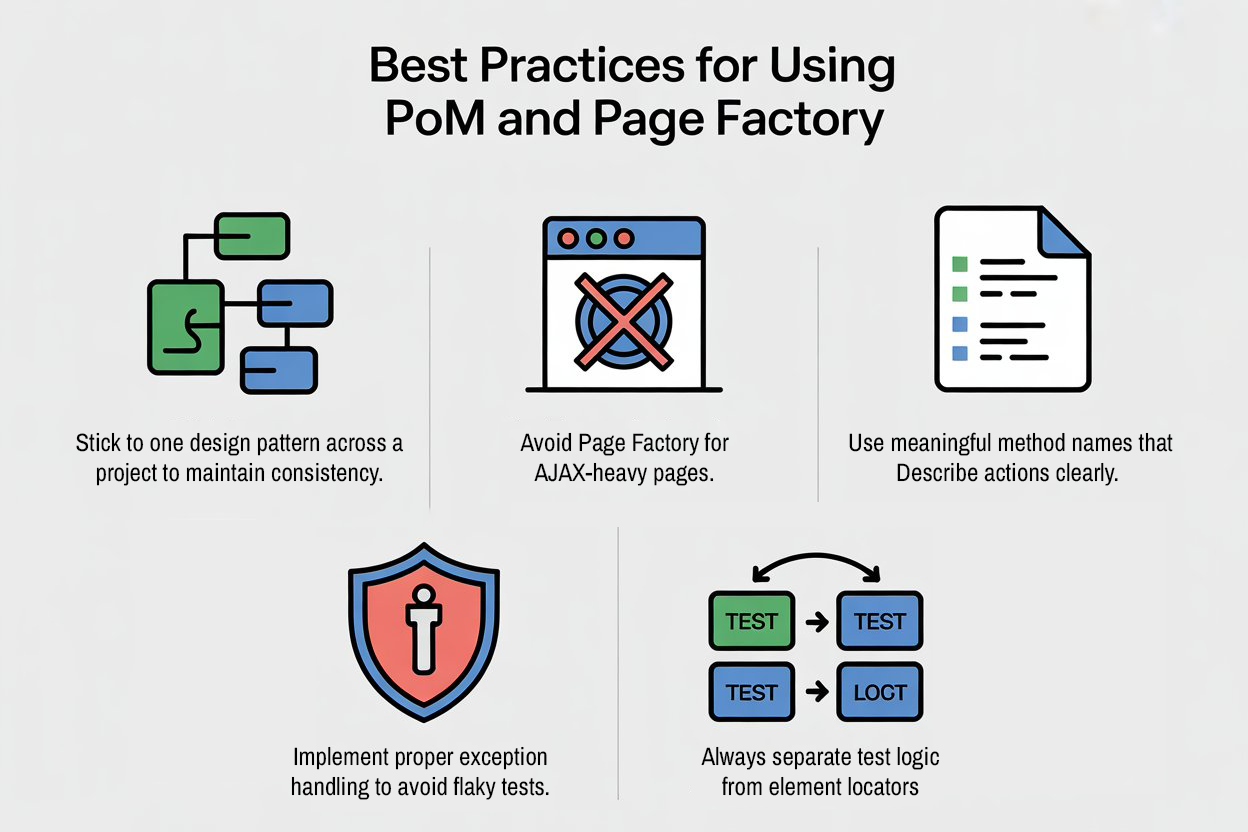In the world of Selenium automation, building a framework that is both maintainable and scalable is not just a luxury—it’s an absolute necessity. As applications grow in complexity, managing test scripts becomes challenging unless they are designed with proper structure and design patterns. Two of the most popular design patterns used in Selenium automation are the Page Object Model (POM) and Page Factory. While both serve the same purpose of abstracting and organizing element locators and interactions, they differ in their implementation, advantages, and ideal use cases.
Choosing the right design pattern in Selenium can make or break your automation framework. Should you go with Page Object Model (POM) or Page Factory? This guide explains the differences, use cases, and best practices to help you scale with confidence. We’ll cover definitions, real-world examples, comparison tables, and FAQs to help you decide.
What is Page Object Model (POM) in Selenium Automation?
The Page Object Model (POM) is a widely used design pattern in test automation that promotes the creation of an object repository for web UI elements. Simply put, every page in your application has its own class in the framework, and all elements (such as buttons, text fields, and dropdowns) along with the methods to interact with them are stored within that class.
This separation of concerns makes the framework more maintainable and scalable. The test logic stays in the test classes, while the element locators and their operations remain inside the page classes.
Example Structure of POM:
public class LoginPage {
WebDriver driver;By username = By.id(“username”);
By password = By.id(“password”);
By loginBtn = By.id(“login”);public LoginPage(WebDriver driver) {
this.driver = driver;
}public void login(String user, String pass) {
driver.findElement(username).sendKeys(user);
driver.findElement(password).sendKeys(pass);
driver.findElement(loginBtn).click();
}
}Here, the test cases will just call `loginPage.login (user, pass)` without worrying about locators.
Popular Articles: automation testing interview questions
What is Page Factory in Selenium?
Page Factory is an extension of POM introduced by Selenium to make code cleaner and reduce boilerplate. It uses annotations like @FindBy and the PageFactory.initElements() method to initialize web elements automatically. This allows you to declare elements in a more concise way and rely on lazy initialization for performance gains.
Example Structure of Page Factory:
public class LoginPage {
WebDriver driver;
@FindBy(id=”username”)
WebElement username;@FindBy(id=”password”)
WebElement password;@FindBy(id=”login”)
WebElement loginBtn;public LoginPage(WebDriver driver) {
this.driver = driver;
PageFactory.initElements(driver, this);
}public void login(String user, String pass) {
username.sendKeys(user);
password.sendKeys(pass);
loginBtn.click();
}
}This makes the code shorter, more readable, and efficient by using lazy loading.
Page Factory vs POM: Key Differences in Selenium Frameworks
| Feature | Page Object Model (POM) | Page Factory |
| Locator Handling | Manual using By locators | Uses @FindBy annotations |
| Initialization | findElement() | PageFactory.initElements() |
| Performance | Slower as every call searches DOM | Faster with lazy initialization |
| Debugging | Easier as locators are explicit | Harder for dynamic locators |
| Use Case | Best for dynamic web apps | Best for stable pages with static locators |
Recommended for You: Product Based Companies in Bangalore
Why Use POM or Page Factory at All?
Without adopting either POM or Page Factory, test automation quickly becomes messy. Imagine writing locators and actions directly inside your test classes. This approach might work for small scripts, but as the test suite grows, it becomes unmanageable. A single change in the application UI could break dozens of test cases.
Both POM and Page Factory offer:
• Reusability – Interact with elements once, reuse across tests.
• Readability – Keep test scripts focused on logic rather than element locating.
• Maintainability – Update locators in one place when elements change.
When to Use Each Pattern
Use POM when:
– Your team is new to Selenium and Java.
– You want complete control over element locators.
– You’re working with dynamic locators or third-party libraries that don’t work well with annotations.
– You prefer explicit coding without annotations.
Use Page Factory when:
– You want faster execution via lazy loading.
– Your project is large and boilerplate reduction matters.
– You are using frameworks like Cucumber or TestNG where cleaner code improves readability.
– You have experience with annotations and want better performance.
Limitations of Page Factory
Although Page Factory seems like an upgraded version of POM, it has its drawbacks:
– No support for dynamic locators (cannot pass values directly into @FindBy).
– Not ideal for AJAX-heavy or highly dynamic pages (lazy loading can break tests).
– Debugging can be tricky, as failed @FindBy annotations are less transparent compared to explicit locators.
Real-World Use Case
Consider a banking application with multiple pages: LoginPage, DashboardPage, and TransferFundsPage.
Using POM, you would create a separate class for each page, defining locators and methods explicitly. This ensures clarity and easier debugging.
Using Page Factory, the same setup becomes more concise and may reduce execution time during parallel test runs because of lazy element initialization. However, this advantage diminishes when working with dynamic UIs.
Best Practices for Using POM and Page Factory
- Stick to one design pattern across a project to maintain consistency.
- Avoid Page Factory for AJAX-heavy pages.
- Use meaningful method names that describe actions clearly.
- Implement proper exception handling to avoid flaky tests.
- Always separate test logic from element locators.

Integration with Test Frameworks
Both POM and Page Factory integrate well with testing frameworks:
– TestNG – Provides structured test execution and reporting.
– Cucumber – Allows writing clean, readable Gherkin steps mapped to Page Object methods.
– Extent Reports / Allure – Reporting tools become more effective when page interactions are abstracted.
Conclusion: Which One’s Better?
There is no one-size-fits-all solution. Page Factory is not strictly better than POM—it is simply an optimized extension. Your choice depends on the project type, complexity, and your team’s skill level.
General Guidance:
– Small Projects → POM for simplicity.
– Large-Scale, Long-Term Projects → Page Factory for efficiency.
– Static Pages → Page Factory works best.
– Dynamic Pages → POM offers better control.
In short:
• POM is simple, clean, and beginner-friendly.
• Page Factory is optimized, annotation-based, and suited for larger projects.
Choose based on your project requirements rather than assuming one is always superior.
FAQs
1. Which is better: Page Factory or POM in Selenium?
POM is simpler and easier to debug, while Page Factory reduces boilerplate and improves performance in large projects.
2.Can Page Factory handle dynamic elements in Selenium?
No, Page Factory is not ideal for dynamic locators. POM works better in such cases.
3.Is Page Factory still used in Selenium 4?
Yes, but many teams stick with POM for flexibility. Page Factory remains useful for cleaner code with static locators.
4.Which is beginner-friendly: POM or Page Factory?
POM is beginner-friendly because it uses explicit locators. Page Factory is better suited for intermediate automation testers.
We Also Provide Training In:
- Advanced Selenium Training
- Playwright Training
- Gen AI Training
- AWS Training
- REST API Training
- Full Stack Training
- Appium Training
- DevOps Training
- JMeter Performance Training
Author’s Bio:

As a Senior SDET with 8+ years in testing and development, I build scalable automation platforms ensuring quality at speed. Passionate about mentoring and innovation, I equip teams with real-time solutions and high-impact frameworks, driving excellence through continuous learning. Let’s shape the future of quality engineering together.
Dilipkumar Rajendran
Senior SDET | Playwright & Selenium Expert








